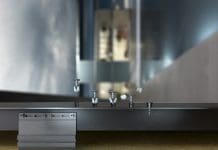PBC Today interviewed engineering leader of UL’s Built Environment Group Mark Swanborough about PAS 24 and Secured by Design
Q) Please can you explain the main differences between PAS 24 and Secured by Design?
A) Secured by Design (SBD) is the official police security initiative that works to improve the security of buildings and their immediate surroundings to provide safe places to live, work, shop and visit. PAS 24 is the actual security testing of window and door products.
Q) Why is it important that we conduct these tests?
A) The tests give the housing development and the actual end user/home owner confidence in the window and door in their property. Testing and certification will help to ensure that a durable, safe, secure and weathertight product is manufactured and installed on site. Approved Document Q of the U.K. building regulations also stipulates that any new dwelling windows and doors should be tested to PAS 24 or a suitable alternative to help ensure adequate security.
Q) How is PAS 24 tested?
Security hardware and cylinder test (doors only)
A) The objective of this is to test the door hardware, lock and cylinders. The test assesses the vulnerability of a cylinder to an attack using knowledge, skill and professional ability. The manual attacks include the attempt to remove, dislodge or otherwise gain access to the cylinder and lock by attacking any protective items. The second assessment attempts to break and defeat the cylinder by applying a twisting and bending force.
Manipulation test
The objective of this test is to establish that there is no inherent vulnerability in the door or window design. The engineer who undertakes the test shall have detailed knowledge of the sample and the hardware installed, such as the location of all locking points. This typically involves the customer sending detailed drawings and sample descriptions before any testing begins.
Manual attacks
Various manipulation methods, such as removing sections of trim or insertion of a tool to disengage locking devices, are carried out. The test engineer may apply sufficient force to explore any potential vulnerability. However, manipulation at any location shall be stopped if permanent deformation or breakage of the chosen tool occurs. Damaged tools should be replaced prior to continuing the testing, but the test must be done on a different place.
Infill manual test
This test is conducted on any window or door infill medium, including glass. The test engineer will attempt to remove gaskets, beads, security devices and the infill medium from the exterior face of the door or window for a period of three minutes. The glass itself must not be broken, but attempts should be made to remove it from the test sample.
Manual cutting test
An attempt to gain entry by generating an aperture in the infill panel of the door leaf is carried out. Glass is not subjected to this test as the safety risk and noise generated by breaking glass is typically avoided by casual burglars. This test is also limited to a period of no more than 3 minutes.
Infill mechanical load test
A load of 2.0 kilonewtons is applied to every corner of any infill medium, including glass, toward the inside of the sample. The load is gradually applied over 10 to 20 seconds to avoid shock and is then held for 10 seconds per location. If failure of the infill medium retention system occurs, the loading tests at points along the remainder of the retention system are carried out in the attempt to gain entry.
Mechanical loading test
The objective of the mechanical loading test is to assess whether the window or door sample can withstand a specified sequence of loading without allowing entry. The loading consists of an application of a parallel to plane load that is applied and held until a perpendicular to plane load has been applied and removed. If a window or doorset allows entry to a gap gauge representing the torso of the attacker during the loading sequence, then this is deemed as a failure. The loads applied represent the forces that a crowbar could apply in those areas. However, the loading is applied by calibrated test equipment as it is deemed a more repeatable and consistent method. Doors are subjected to 4.5kN loads, and windows 3.0kN loads at predefined points as described in PAS 24.
Manual check test
The objective of this test is to explore the possibility that there may be weaknesses and vulnerabilities in the product not covered in the standard cases. The manual check test is carried out from the exterior face of the sample and conducted with full knowledge of the sample’s construction and hardware details. The tools used for this test include two flat-bladed screwdrivers and two nail bars. Attempts are made to apply loads to ends of locking devices, and attacks are made at unsupported corners.
Impact testing (doors only)
This test aims to assess the doorsets’ resistance to impacts from a soft body and hard body. For soft body impacting, a 30.0kg bag strikes the door leaf at 0.8m, 1.25m and at 1.7m above floor level. The impacts are carried out on all types of infill to represent a person falling into a door or deliberately running into a door leaf to try and gain entry. Hard body impact tests using a 50.0 kg steel cylinder are conducted to further assess the strength of the door set.
Q) How is Secured by Design tested?
A) SBD is not a product testing method or test standard itself. Instead, a handful of organisations, including UL, are approved by SBD to provide testing and third-party certification in line with the initiative’s requirements. SBD was formed in 1989 and is credited with helping to reduce break-ins and burglaries substantially. Windows and doors complying with SBD specifications form part of the front line of defence against unlawful entry. They can help homeowners not only to enjoy greater security but also to reduce their household insurance premiums. Some of those requirements include PAS 24, BS 6375-1, 2 and 3 tests of the window and door products and the certification of the fabricator/manufacturer, which includes initial and ongoing site audits to assess the factory product control systems in place.
Q) Can these security standards be improved? How?
A) Yes, standards are regularly reviewed and updated every couple of years to ensure that they are still relevant. They are updated to help remedy any issues with the current standards and cover new products in the marketplace.
Want to know more? Visit UL’s website









![[Video] Enhancing safety with fire doors: A case study of Marina Care Home](https://www.pbctoday.co.uk/news/wp-content/uploads/2025/06/maxresdefault-218x150.jpg)




